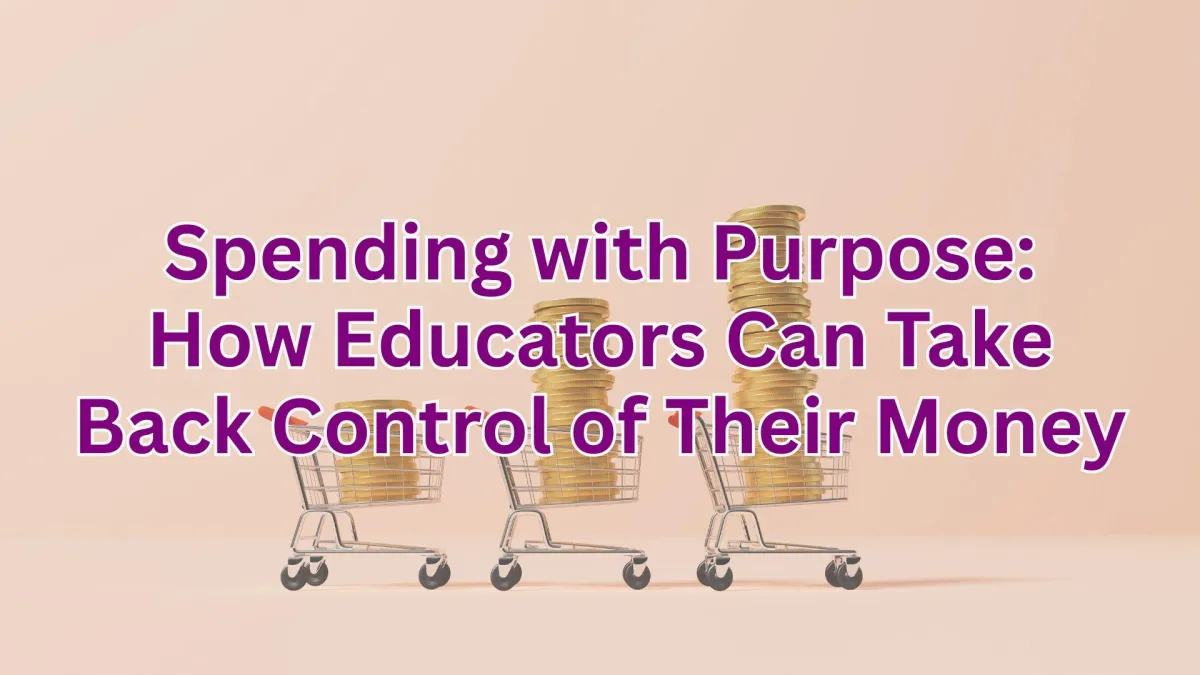
Spending with Purpose: How Educators Can Take Back Control of Their Money
📚 Introduction: Where Did My Paycheck Go?
Ever found yourself staring at your bank account and thinking, “Wait… where did all my money go?” If you're an educator, you're definitely not alone. Between lesson planning, grading papers, and inspiring the next generation, it’s no wonder budgeting often takes a backseat. But here’s the truth—we don’t need more money to feel more in control. What we need is a spending strategy that works for our real lives.
Let’s talk about intentional spending. It’s not about being frugal or giving up your favorite latte. It’s about making sure your dollars are doing what you actually want them to do. And if you're ready to stop feeling behind and start feeling empowered—this article’s for you.
🎯 What Is Intentional Spending, Anyway?
Imagine if every dollar you spent moved you closer to something you cared about. That’s the heart of intentional spending.
Instead of reacting to every sale, impulse, or “treat yourself” moment, intentional spenders pause and ask:
Does this purchase line up with my values?
Will I be glad I spent this money tomorrow?
Am I choosing this—or just spending by habit?
Intentional spending = conscious choices. It's not a budget—it's a mindset. And it works wonders for teachers, administrators, coaches, and anyone living on an educator’s paycheck.
🎯 Why Educators Struggle with Spending
We don’t talk about this enough, but there are some real challenges educators face when it comes to managing money:
Irregular income: Substitutes, adjunct faculty, and summer break pay gaps make it hard to predict cash flow.
High emotional labor: After long, stressful days, it’s easy to fall into “I deserve this” spending.
Giving hearts: Teachers often spend out-of-pocket for classroom supplies or student needs.
Limited financial education: Many of us were never taught how to plan, save, or invest wisely.
Sound familiar? Don’t worry—you’re not doing it wrong. You’re just ready for a better plan.
💡 Why Intentional Spending Works for Educators
Intentional spending isn't about guilt or restrictions—it’s about clarity, confidence, and alignment.
When you know where your money is going:
You feel less stressed when bills come around.
You stop the endless cycle of “catch-up” spending.
You build toward goals that actually excite you—like paying off debt, buying a home, or retiring on your terms.
And here’s the best part—it’s not hard to start.
✏️ The 5-Step Intentional Spending Framework for Educators
Let’s break it down into simple, doable steps that work whether you're a new teacher or a veteran of the profession.
1. Get Clear on Your Values
Ask yourself: What matters most to me right now?
Your values might include:
Being debt-free
Traveling with family
Saving for a home
Giving to causes you love
Building a retirement cushion
Once you’re clear, your spending choices become easier.
2. Track Without Shame
For one week, just watch where your money goes—no judgment. Use a notebook, app, or even sticky notes.
Look for surprises like:
Auto-renewing subscriptions
Eating out more than expected
Emotional spending after tough workdays
Awareness = power.
3. Assign Every Dollar a Job
Think of your paycheck like a group of tiny employees. Each one needs a task.
Break it down into:
Needs (rent, groceries, gas)
Wants (streaming, hobbies, eating out)
Goals (savings, debt payoff, retirement)
This is called zero-based budgeting, and it helps you feel in control—even with a small income.
4. Build in “Yes” Money
Don’t cut out all the fun! That’s a recipe for burnout. Instead, give yourself a monthly “Yes” fund.
Use it for:
Teacher Happy Hours
Coffee shop grading days
Self-care or hobbies
It keeps you motivated while staying on track.
5. Adjust Monthly
Life changes—your budget should too. Every month, revisit your values and spending.
Ask:
What worked?
What didn’t?
What can I tweak for next month?
Intentional spending is a practice—not a perfect science.
❤️ Real Talk: What Happens When Educators Spend with Purpose
Here’s what educators say after shifting to intentional spending:
“I finally feel like I have a say in where my money goes.”
—Rebecca, 5th grade teacher, Michigan
“I was able to save $500 in just three months without feeling deprived.”
—Luis, adjunct professor, California
“For the first time, I’m not dreading summer break because I planned for it.”
—Tamika, high school counselor, Georgia
💬 FAQs About Intentional Spending for Educators
Q: I barely make enough to get by. Is intentional spending even possible for me?
Absolutely. It’s not about how much you make—it’s about how you use what you have. Many low-income earners gain big control by aligning money with values.
Q: Do I need a fancy app or a financial advisor?
Nope. A pen and paper work great. The real magic is in your mindset.
Q: What if my partner isn't on board?
Start with your own money first. Share your wins. People often come around when they see results.
🔥 Ready to Take Back Control?
It’s time to stop letting your paycheck slip through your fingers. Intentional spending is the first step toward financial peace—and it doesn’t mean sacrificing everything you love.
So here’s your challenge for the week:
👉 Pick one spending area to track for the next 7 days.
Maybe it’s eating out, classroom expenses, or Amazon orders. Just track it. No guilt. Just data.
Then ask: Did this spending reflect my values?
Come back and let me know what you learned. Or drop a comment below sharing your “aha!” moment. Let’s grow through this—together.
Let’s make this the year we stop surviving and start thriving. One dollar at a time. 💪